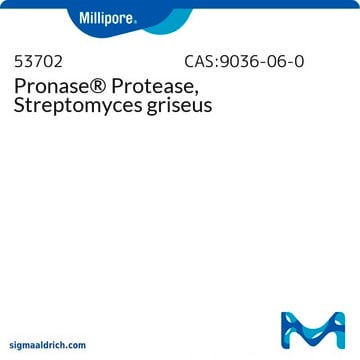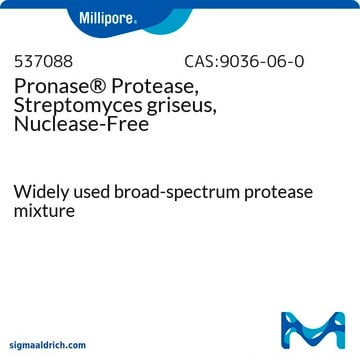P5147
Protease from Streptomyces griseus
Type XIV, ≥3.5 units/mg solid, powder
Synonym(s):
Actinase E, Pronase E
About This Item
Recommended Products
biological source
Streptomyces griseus
Quality Level
type
Type XIV
form
powder
specific activity
≥3.5 units/mg solid
solubility
10 mM NaAc (pH 7.5) and 5 mM CaAc: soluble 0.2 mg/mL at 37 °C, clear, colorless to tan
shipped in
wet ice
storage temp.
−20°C
Looking for similar products? Visit Product Comparison Guide
Related Categories
Specificity
Application
- for the digestion of nucleus pulposus (NP) tissue
- in the catalysis of asymmetric one pot Mannich reaction
- for deproteinization of starch
- digestion of brain slices for the cell dissociation
Biochem/physiol Actions
Features and Benefits
- highly stable in pH range of 5.0 to 9.0, with peak activity at pH 8.8
- compatible with many DNA and RNA isolation buffers
- broad substrate specificity
Quality
Physical properties
Unit Definition
Preparation Note
related product
Signal Word
Danger
Hazard Statements
Precautionary Statements
Hazard Classifications
Eye Irrit. 2 - Resp. Sens. 1 - Skin Irrit. 2 - STOT SE 3
Target Organs
Respiratory system
Storage Class Code
11 - Combustible Solids
WGK
WGK 2
Flash Point(F)
Not applicable
Flash Point(C)
Not applicable
Personal Protective Equipment
Certificates of Analysis (COA)
Search for Certificates of Analysis (COA) by entering the products Lot/Batch Number. Lot and Batch Numbers can be found on a product’s label following the words ‘Lot’ or ‘Batch’.
Already Own This Product?
Find documentation for the products that you have recently purchased in the Document Library.
Customers Also Viewed
Our team of scientists has experience in all areas of research including Life Science, Material Science, Chemical Synthesis, Chromatography, Analytical and many others.
Contact Technical Service














